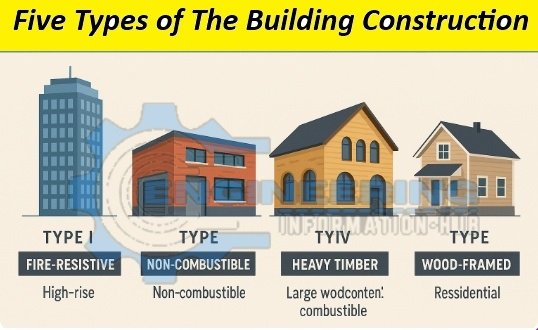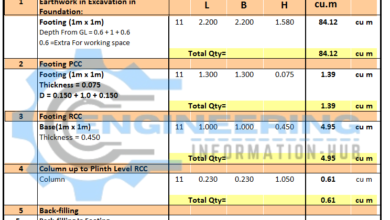Five Types of The Building Construction
Five Types of The Building Construction| Types of The Building Construction

Five Types of The Building Construction
Have you ever passed by a building and wondered why some structures stand firm and solid for decades while others seem weak or start to deteriorate early? You’re not alone. The truth is, much of this difference comes down to how accurately the building takeoff was done during the construction planning phase. A precise takeoff ensures the right quantity of materials, proper structural balance, and durability, affecting everything from a building’s lifespan to how it withstands fire, weather, and time. Five Types of Building Construction
The following is the brief answer: there are five types of building structure: Fire-Resistive (Type I), Non-Combustible (Type II), Ordinary (Type III), Heavy Timber (Type IV), and Wood-Framed (Type V). The types are of different strengths, costs, and level of safety, and this determines the modern ways of building cities.
We will dissect what these entail to you, be it in terms of constructing a new building, calculating the cost of construction, or just being interested to know how these buildings are made.
The Reason Why the Types of Building Construction are Important to Understand
It is always important to understand the behavior of the structure itself before making any decisions on the choice of materials and design. Every type of building has a delicate balance in regard to safety, cost, and purpose. There is no way that a hospital and a wooden cabin can have the same structure, and that is where these categories come into the picture.
When professionals perform construction estimation, they start by carefully evaluating the quantity of materials used in the project. This assessment plays a crucial role in defining the foundation design, material requirements, overall cost, project duration, and fire safety considerations, ensuring precise budgeting and efficient project planning right from the beginning.
The point is, after getting familiar with these five types, you will never have an eye on buildings in the same way.
Type 1 Fire-Resistive Construction: The Strongest and Safest Building Type
Were safety given a face, the construction would resemble Type I. These include the high-rise buildings and the giant hospitals that are meant to resist the high heat and fire. Their secret? The concrete and the shielded steel frames that are capable of withstanding fire, several hours without collapsing its power.
This type is built to last. Walls, floors, and roofs are non-combustible, and this is the reason Type I buildings have the highest fire-resistance rating among other classes. Such structures are stable enough to evacuate and fight the fire even under extreme temperatures.
Simply put, Type I is the armored fortress, safe, durable and strong. The downside? It’s expensive. However, in buildings where property and human lives have the highest value then that price is worth a penny.
Type 2 Non-Combustible Buildings: The Reliable Choice for Modern Safety Standards
Type II buildings are practical relatives of Type I. They also consist of the same non-combustible materials like steel and concrete, only that they lack the same fireproofing protection or the protection of heavy-duty. This kind can be found in the shopping malls, contemporary schools, and middle-sized office parks.
Although such buildings can withstand fire outbreaks, they can lose structural integrity in cases of extreme temperatures. Nevertheless, they provide an intelligent compromise between safety and price – and they are a popular option in urban settings.
Type II construction is efficient and that is its true beauty. It offers sufficient protection to the people’s areas without the exorbitant expenses of high-rise quality products.
Type 3 Ordinary Construction: Versatile, Durable, and Cost-Effective Building
Now, this one’s interesting. In Type III, or ordinary construction, the hero is the hybrid one who is powerful enough to go up and at the same time, pliable enough to change. These buildings typically have exterior walls that are made of non-combustible materials such as brick or block and the interior is made of wood flooring, beams, and roofing.
You will find plenty of them, in the form of small apartment complexes, commercial shops, older warehouses, or even neighborhood markets. They are a combination of low cost and moderate fire safety hence they are perfect with mixed use buildings.
This is what has made Type III so popular: it can be repaired, modified and expanded easily. The reason why contractors are fond of it is that it is affordable in cost and in durability and the reason why the owners are fond of it is because it enables one to build creative architecture without having to strain the bank account.
Naturally, there is a catch: only the outer shell can withstand the flames, but the inside wooden frame may also be burnt. In such a way, routine checking and maintenance is necessary.
Type 4 Heavy Timber Construction: Strong, Sustainable, and Timeless Design
Would you speak about charisma and power combined? Type IV or heavy timber construction is the old-world of building craftsmen. Imagine old churches or old factories or old apartment lofts with their beams open and their old wooden columns.
What makes this kind of beauty is that it has huge woody parts. These plank timbers are not easily burnt, indeed, they are better resistant to fire than smaller lumber. The external chars gradually arsons away, and the interior does not burn away.
This kind also possesses a soul, the bare wood is warm and beautiful and the modern concrete can never replicate the same. Also, it is environmentally friendly because when wood is sourced responsibly, the wood is renewable.
Still, maintenance is key. Timber that is heavy must be treated frequently against moisture, insects and rottenness to retain its strength and eternal look.
Type 5 Construction Wood-Framed, Affordable, and Perfect for Modern Homes
Lastly is Type V, which is the most widespread type of building construction, both at home and small buildings. It is a form that is based mainly on wood framing, thus it is flexible, affordable, and has a fast construction process.
Probably, that means you live in a Type V building (a suburban house). The explanation behind its popularity is very simple, it provides good insulation, economy, and freedom in designing. Layouts can be easily changed, new rooms added or the aesthetic changes made by builders.
However, there is a disadvantage to this, which is that wood burns and therefore Type V is the one that is least resistant to fire amongst all the five types. This kind can also help in giving long-lasting comfortable houses with the right fire-retardant material and safety planning.
Concisely, Type V is the useful all-purpose one, slim, flexible and economical.
The Welcome to Raising a Building
A choice of a type of construction is not about money or appearances. It is concerned with intent and defense.
Choosing the Right Type
- Type I is the safest by all means in case you are constructing a high-rise or hospital.
- In the case of offices or schools, Type II provides a balance of safety and cost.
- Type III is flexible and easy to upgrade.
- Desire natural beauty and power? Type IV is the winner.
- Type V beats off affordability and efficiency still in the homes or little projects.
The trick is that you need to correspond the level of risk with the functionality of your project. The needs of a fireproof skyscraper are completely different, as well as the ones of a countryside cabin, that is why these two categories are created.

The Unspoken Secret of the Construction Type
The point that most human beings overlook is that it determines not only the safety, but also insurance rates, resale value, and even maintenance costs in the long term, the type of construction to use.
Homes having a better fire rating will be able to pay lower insurance premiums, and will also have an increased value attached to them. Conversely, the cost of repairs in the future can be so expensive as one makes a decision without regard to the environment and the way the type is used.
Simply, the backbone of your structure is what determines your future.
therefore, the 5 types of building construction are not mere names. They are the design of safety, strength, and sustainability. When it comes to concrete giants of Type I and the warm wooden houses of Type V, each of them contributes significantly to the construction of our cities and communities.
You know what to make them different and then you no longer build but build smarter. You are an architect or you are a homeowner or you are a person planning a project in the future, whatever you do, bear in mind that there is no great construction without the right foundation, both in design and decisions.
Which construction of a building is the most durable?
Type I (Fire-Resistive) constructions tend to be the oldest due to using concrete and steel, which can withstand fire, moisture, and structural forces for many decades or even a century or longer.
Which type is the most used in residential houses?
The most common type of residential building is type V (Wood-Framed). It is cheap, easy to put together and quick to assemble and that is why it is the ideal choice for many homeowners.
What is the frequency of updates to building codes of such types of construction?
The building codes are usually updated every 3 to 5 years and this ensures that the standards of safety and the introduction of new materials are in line with the technological advancements.
Is it possible to turn a building into another?
Yes, with major renovations. As an example, a more ancient Type III building may be refined with fireproofing and reinforcements with steel to achieve Type II. Nevertheless, appropriate engineering tests are needed when such conversions are carried out.







